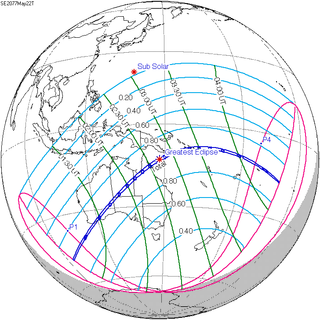
Summary
A total solar eclipse will occur on Saturday, May 22, 2077. A solar eclipse occurs when the Moon passes between Earth and the Sun, thereby totally or partly obscuring the image of the Sun for a viewer on Earth. A total solar eclipse occurs when the Moon's apparent diameter is larger than the Sun's, blocking all direct sunlight, turning day into darkness. Totality occurs in a narrow path across Earth's surface, with the partial solar eclipse visible over a surrounding region thousands of kilometres wide.
| Solar eclipse of May 22, 2077 | |
|---|---|
 Map | |
| Type of eclipse | |
| Nature | Total |
| Gamma | −0.5725 |
| Magnitude | 1.029 |
| Maximum eclipse | |
| Duration | 174 s (2 min 54 s) |
| Coordinates | 13°06′S 148°18′E / 13.1°S 148.3°E |
| Max. width of band | 119 km (74 mi) |
| Times (UTC) | |
| Greatest eclipse | 2:46:05 |
| References | |
| Saros | 129 (55 of 80) |
| Catalog # (SE5000) | 9681 |
Related eclipses edit
Tritos edit
- Preceded: Solar eclipse of June 22, 2066
- Followed: Solar eclipse of April 21, 2088
Tzolkinex edit
- Preceded: Solar eclipse of April 11, 2070
- Followed: Solar eclipse of July 3, 2084
Solar eclipses 2076–2079 edit
This eclipse is a member of a semester series. An eclipse in a semester series of solar eclipses repeats approximately every 177 days and 4 hours (a semester) at alternating nodes of the Moon's orbit.[1]
| Solar eclipse series sets from 2076 to 2079 | ||||
|---|---|---|---|---|
| Ascending node | Descending node | |||
| Saros | Map | Saros | Map | |
| 119 | June 1, 2076 Partial |
124 | November 26, 2076 Partial | |
| 129 | May 22, 2077 Total |
134 | November 15, 2077 Annular | |
| 139 | May 11, 2078 Total |
144 | November 4, 2078 Annular | |
| 149 | May 1, 2079 Total |
154 | October 24, 2079 Annular | |
Saros 129 edit
It is a part of Saros cycle 129, repeating every 18 years, 11 days, containing 80 events. The series started with partial solar eclipse on October 3, 1103. It contains annular eclipses on May 6, 1464 through March 18, 1969, hybrid eclipses from March 29, 1987 through April 20, 2023 and total eclipses from April 30, 2041 through July 26, 2185. The series ends at member 80 as a partial eclipse on February 21, 2528. The longest duration of totality was 3 minutes, 43 seconds on June 25, 2131 . All eclipses in this series occurs at the Moon’s ascending node.[2]
| Series members 46–56 occur between 1901 and 2100: | ||
|---|---|---|
| 46 | 47 | 48 |
| February 14, 1915 |
February 24, 1933 |
March 7, 1951 |
| 49 | 50 | 51 |
| March 18, 1969 |
March 29, 1987 |
April 8, 2005 |
| 52 | 53 | 54 |
| April 20, 2023 |
April 30, 2041 |
May 11, 2059 |
| 55 | 56 | |
| May 22, 2077 June 2, 2095 | ||
Inex series edit
This eclipse is a part of the long period inex cycle, repeating at alternating nodes, every 358 synodic months (≈ 10,571.95 days, or 29 years minus 20 days). Their appearance and longitude are irregular due to a lack of synchronization with the anomalistic month (period of perigee). However, groupings of 3 inex cycles (≈ 87 years minus 2 months) comes close (≈ 1,151.02 anomalistic months), so eclipses are similar in these groupings.
In the 19th century:
- Solar Saros 120: Total Solar Eclipse of 1816 Nov 19
- Solar Saros 121: Hybrid Solar Eclipse of 1845 Oct 30
- Solar Saros 122: Annular Solar Eclipse of 1874 Oct 10
| Inex series members between 1901 and 2100: | ||
|---|---|---|
| September 21, 1903 (Saros 123) |
August 31, 1932 (Saros 124) |
August 11, 1961 (Saros 125) |
| July 22, 1990 (Saros 126) |
July 2, 2019 (Saros 127) |
June 11, 2048 (Saros 128) |
| May 22, 2077 (Saros 129) |
||
In the 22nd century:
- Solar Saros 130: Total Solar Eclipse of 2106 May 03
- Solar Saros 131: Annular Solar Eclipse of 2135 Apr 13
- Solar Saros 132: Hybrid Solar Eclipse of 2164 Mar 23
- Solar Saros 133: Total Solar Eclipse of 2193 Mar 03
Notes edit
References edit
- Earth visibility chart and eclipse statistics Eclipse Predictions by Fred Espenak, NASA/GSFC
- Google interactive map
- Besselian elements


